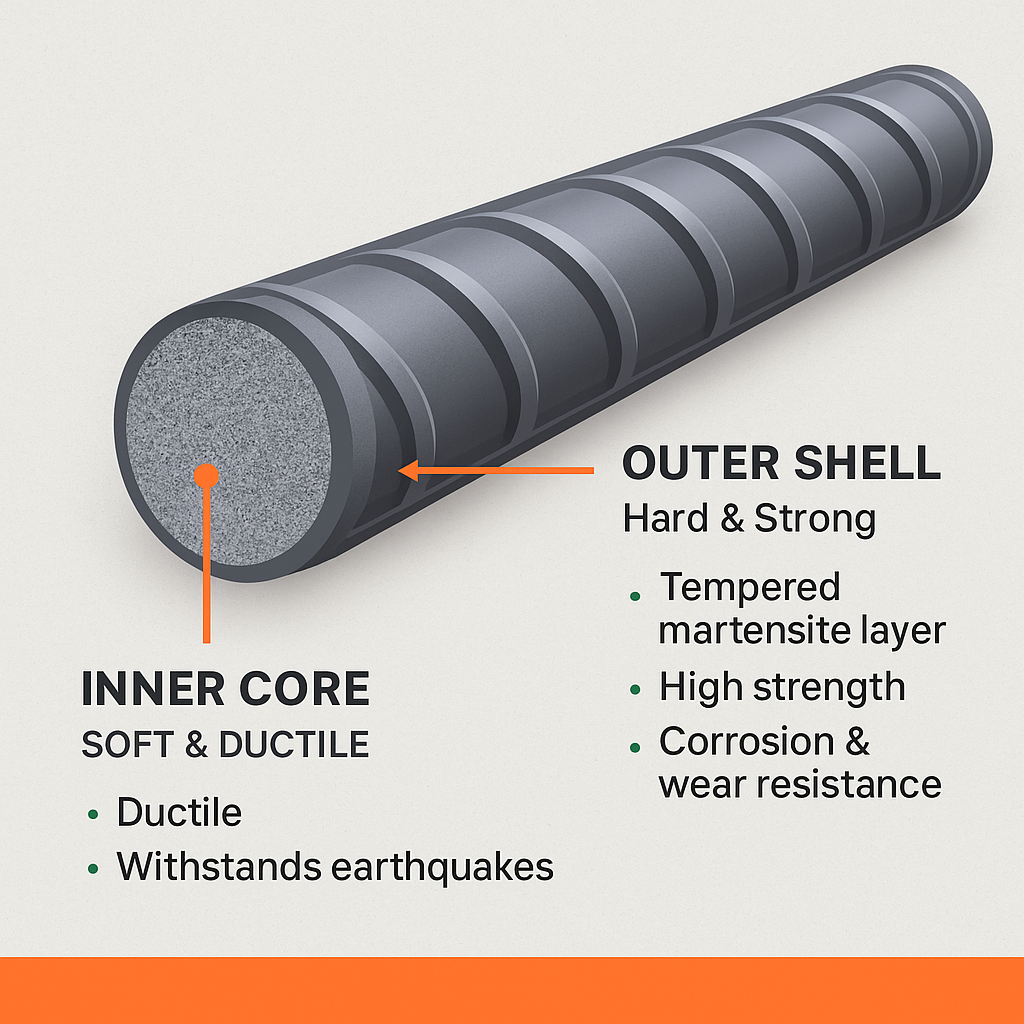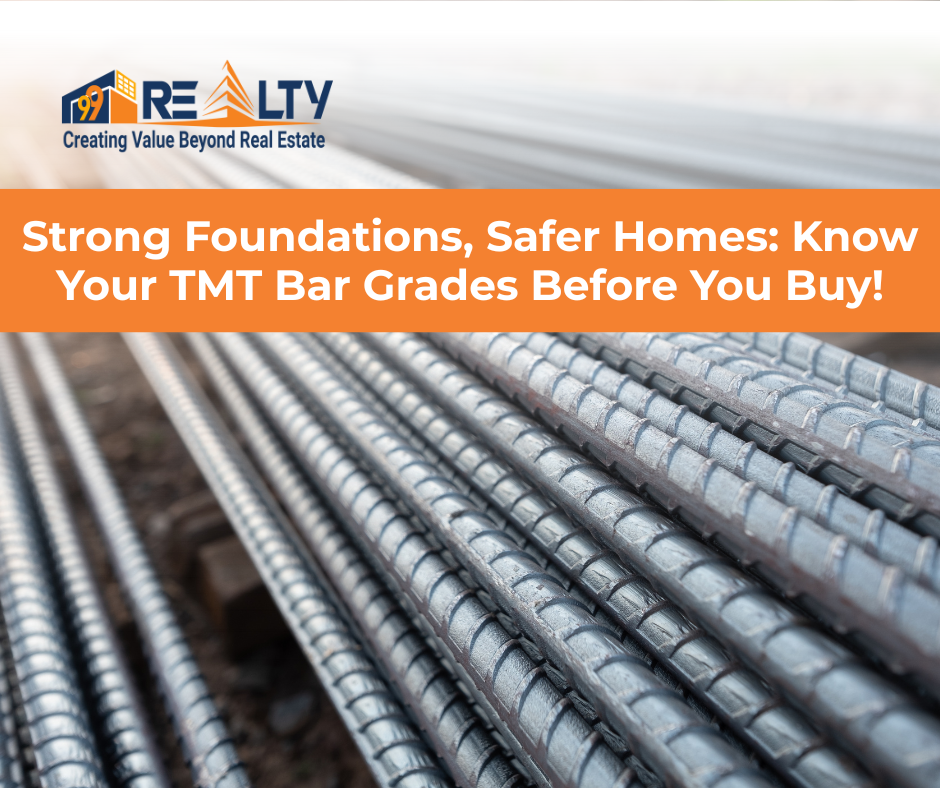Buying a home in India is one of the biggest investments you’ll ever make — emotionally and financially. But how often do you ask the builder, “Which TMT bars or grades were used in my building?” If your answer is never, you’re not alone. Most homebuyers focus on the paint, tiles, and modular kitchen — but completely ignore what’s holding the structure together.
Let’s fix that today. This guide will help you understand TMT bars, grades, and why this knowledge is non-negotiable for every Indian homebuyer.
Understanding RERA Escrow Account: Safeguarding Homebuyers
Why This Knowledge Matters to Every Homebuyer in India
Would you buy a car without checking its engine specs? Probably not.
So why invest in a home without knowing the grade of steel used in its structure? TMT bars are the skeleton of your house — they determine how long it stands, how safe it is during an earthquake, and how it ages with time.
This isn’t just engineer talk — it’s basic homebuyer sense.
What are TMT Bars?
TMT Meaning (With Simple Example)
TMT stands for Thermo Mechanically Treated bars. It’s a fancy name for strong steel bars that are made through a special heating and cooling process.
Example: Think of it like making jalebis. The hot sugar syrup makes them hard on the outside but soft inside — just like TMT bars! The outside is hard for strength, and the inside stays soft so it can bend without breaking.

How Are They Made? (In Simple Words)
- Steel is heated at high temperatures.
- Then it is cooled very fast using water.
- This creates a strong outer layer and a soft, bendable inner part.
This method makes the bars both strong and flexible — perfect for buildings.
Why Do Buildings Need TMT Bars?
1. They Make the Building Strong
Without these bars, concrete (cement) alone can crack or break easily. TMT bars hold everything together and give strength.
2. Help in Earthquakes
In India, many cities face small earthquakes. TMT bars absorb shock and prevent big cracks in your home.
Example: Like how the suspension in your bike absorbs speed bumps — TMT bars do the same for your building during a quake.
3. Fire Protection
These bars can survive up to 600°C — that means they don’t melt easily in case of fire. Safety first!
Understanding TMT Grades in India (Like School Grades!)
Think of grades like school marks — higher grade = more strength.
Fe 415 – For Small Homes
- Used in 1 or 2-floor houses.
- Good strength, low cost.
- Not great for earthquake areas.
Example: Like a basic Nokia phone — works well, but no extra features.
Fe 500 – Most Common Grade in India
- Used in most apartments and buildings.
- Strong and slightly flexible.
- Good for cities with mild earthquakes.
Example: Like a smartphone with good battery and performance — balanced and reliable.
Fe 500D – ‘D’ is for Ductile (Bendable)
- More flexible than Fe 500.
- Best for earthquake zones.
- Builders in Bihar, Delhi, North East, or Himachal often use this.
Example: Like a rubber band that stretches but doesn’t break.
Fe 550 / Fe 600 – For High Buildings
- Used in big towers, bridges, factories.
- Very strong but less bendable.
- Not required for small homes.
Example: Like a sports car — powerful, but not needed for daily commute.
| Grade | Use | Strength | Flexibility | Cost | Best For |
|---|---|---|---|---|---|
| Fe 415 | Low-rise | Moderate | High | Low | 1-2 floor homes |
| Fe 500 | Mid-rise | High | Medium | Moderate | Apartments |
| Fe 500D | Mid-rise | High | High | Moderate | Earthquake zones |
| Fe 550/600 | High-rise | Very High | Low | High | Bridges, towers |
What Does ‘Fe’ Mean? (Quick Science)
‘Fe’ comes from Ferrum, which is Iron’s symbol in chemistry.
- Fe 500 means the bar can take a pressure of 500 Megapascal (MPa).
- More number = More strength.
Example: It’s like lifting weights — Fe 415 can lift 415 kg/sq.cm, Fe 500 can lift 500 kg/sq.cm. Stronger = better.
What is Ductility? (With Example)
Ductility means how much a bar can bend without breaking.
- Ductile bars don’t snap during earthquakes.
- They save your home from falling apart.
Example: Compare two wires — one bends like a rubber wire, the other snaps like a dry stick. You want the rubbery one in your building.
Mistakes People Often Make
- “My builder knows best.” — Not always true.
- “My home looks strong from outside.” — But the inside matters more.
- “All bars are the same.” — No! Fe 500D is very different from Fe 415.
Don’t guess. Ask and check.
How to Check the Quality of TMT Bars in Your Building
1. Ask for a Test Certificate
Every good builder should give you a TMT bar test report, showing:
- Grade (Fe 500, Fe 500D, etc.)
- Brand name
- Lab test results
- IS code compliance
If they refuse, be careful.
2. Choose Branded Bars Only
Branded TMT bars are tested and certified. They last longer and are safer.
Top TMT Bar Brands in India
Here are trusted names you can look for:
- Tata Tiscon
- JSW Neosteel
- Kamdhenu
- SAIL
- Shyam Steel
- Jindal Panther
Ask your builder: “Which brand of TMT did you use?” If it’s local or unknown — ask more questions.
Primary vs Secondary Steel: What’s the Difference?
- Primary Steel – Made from iron ore. Pure and strong.
- Secondary Steel – Made by melting scrap metal. Cheaper but weaker.
Always ask for primary steel — your safety depends on it.
Why Bar Grade Decides Your Home’s Life
Right TMT grade = Long life, low repairs.
- Better bars mean fewer cracks.
- They fight rust (corrosion) better.
- Your home stays strong for 50+ years.
Bad bars = risk during heavy rains, quakes, or even over time
5 Questions You Must Ask Your Builder
- Which TMT bar grade did you use?
- Is it Fe 500D or better?
- Can I see the test certificate?
- Is the steel primary or secondary?
- Is this grade good for earthquake zones?
Don’t feel shy — you’re investing your life’s savings. You have full rights to ask.
Final Thoughts
The truth is, people focus too much on tiles, paint, and balconies. But the real strength of your home is inside — in the bars and steel.
So next time, before buying or building a home, ask the right questions. It’s your money, your safety, and your future.
And remember — it’s not just a house. It’s your family’s shelter.
FAQs
1. What is the best TMT grade for a small house?
Fe 500 or Fe 500D is perfect for most homes up to 3 floors. Choose Fe 500D if you’re in an earthquake-prone area.
2. How can I check if the builder used good bars?
Ask for a lab test certificate or material invoice. Look for branded names and ISI marks on the bars.
3. What happens if bad quality bars are used?
Your home may crack faster, get damaged during earthquakes, or need repairs much earlier than expected.
4. Are branded bars too costly?
Not really. They may cost ₹2-3 extra per kg, but they save you lakhs in the long run through better safety and fewer repairs.
5. Do builders use the same TMT bars in every city?
No. Builders choose based on city, soil, earthquake risk, and budget. You should ask what’s right for your location.
Need Help?
Need help evaluating a property or planning your next move in the market?
Reach out to 99 REALTY – your trusted real estate partner for smarter choices.
Subscribe to get updates on our latest posts and market trends.






Join The Discussion